May 17, 2007
Who is FortiusOne?
FortiusOne is not yet a household name in geospatial, but I suspect it will be soon. I first learned of one of the company’s founders in 2003, when he made the Washington Post. Sean Gorman, now CEO of FortiusOne, got into trouble for putting together "detailed maps of U.S. infrastructure along with the fiber-optic network that connects businesses and government. The data was all collected from public sources."
Back then, Gorman was a grad student at George Mason University. He started FortiusOne in 2005 with two professors to support work for the U.S. Department of Homeland Security. Markets Growth Fund and Walker Ventures provided the $500,000 in funding that got the company off the ground. FortiusOne secured another round of funding last week.
FortiusOne launched GeoIQ Web Services, a platform that "empowers you to go beyond pushpin data displays to add geographic intelligence to your maps," last year. (Location Intelligence ran a product overview.) More recently Gorman has been prepping for the next big thing: a repository for geodata available for mashups. Called GeoCommons, it's being announced today and will go live next week at the Where 2.0 Conference. I received a briefing from Gorman on a development version of the website last week.
GeoCommons
GeoCommons is quite a few things rolled into one. It's a website to:
- upload, download and search for spatial data
- easily create mashups by combining datasets
- tell stories that are best told with real data on real maps
- the ability to create heat maps, a type of thematic map
- data available under "Creative Commons with Attribution" licensing
- proprietary geospatial data storage and search tools
GeoCommons in Action
The free site allows users to set up an account and profile, and upload their own datasets (after carefully reading the licensing information). Data must be public domain and can be uploaded in KML or shapefile format. (A future release will create these files from address information, that is, it'll do geocoding.) Datasets can be tagged and include a description, though no formal metadata tool is offered (at this time). Shapefile datasets are converted to KML, GeoCommons' "native" format. Alternatively, users can search for already loaded datasets based on geography and topic. Those datasets are fuel for mashups.
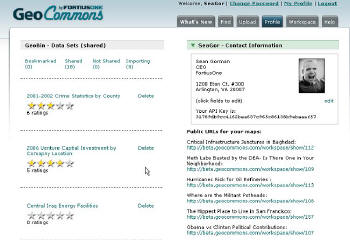 |
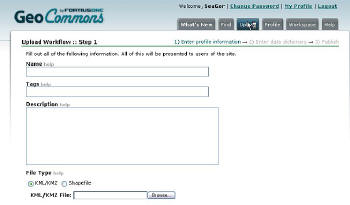 |
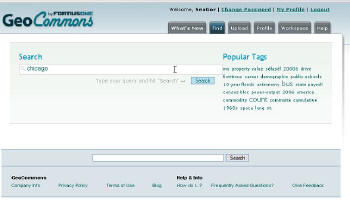 |
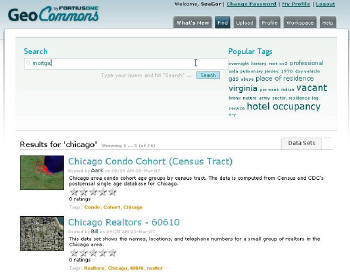 |
When a dataset is added to a new map it can be displayed as points and shapes and/or a heat map. A heat map is a thematic map of one or more variables based on FortiusOne's underlying mathematics. It's a "relative" map so no formal legend is provided. You can, however, look at the raw data to get a sense of the ranges and to see the values at specific locations.
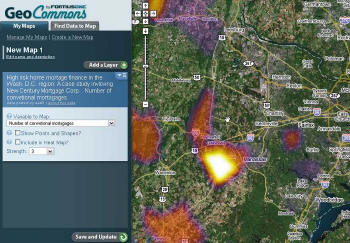 |
Saving a map involves giving it a name and description. At that point you can make the map public or private. Maps can be either, but datasets must be public, reinforcing the idea of a "commons." For now, registered users are provided with public URLs for their public maps. In the future, FortiusOne plans to add tools to embed maps in Web pages and blogs.
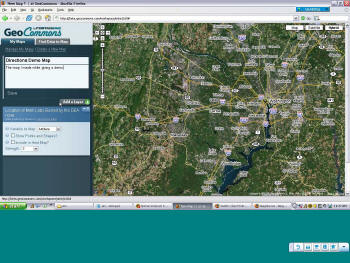 |
FortiusOne has two ways to monetize GeoCommons. One involves a sort of "higher level" fee-based membership for individuals or organizations that want to tell the story around their cause in more detail. An environmental organization might have such a profile to tell its story of conservation or a political group might use it in a campaign to highlight inequities. A second monetization option revolves around those with data they can't (or choose not to) share. They pay a subscription to use the tools of GeoCommons along with their proprietary data. The model, says Gorman, is akin to Salesforce.com's hosted service for businesses.
My Take
This is a truly unique addition to the Web 2.0 world of mapping. I can't think of a real competitor. This is not Google My Maps because you can upload your own datasets. It's not Platial since there's no social, "here's where I went on my vacation" aspect to it. It's not a global spatial data infrastructure since there's no government involved!
So what is it? It's a place to share – not just maps, but data. It's a place to tell stories – stories about the environment, politics, natural disasters, real world topics. And, it's a mapping tool aimed at regular people. Gorman explained that the team took out lots of the high-end geospatial analytical tools in an earlier beta because they confused non-technical users. The plan is to slowly add those in as users become comfortable with the application.
There are challenges. Will users upload datasets? FortiusOne hopes so and has been seeding GeoCommons with public datasets on its own. Will the data follow the public domain creed? Again, FortiusOne hopes so and has staffers to review datasets and remove them should they be inappropriate (not unlike YouTube). Will enough paying customers step up to fund the free version? FortiusOne is optimistic, especially after the Department of Homeland Security acquired its technology specifically because its non-technical users could combine and use data quickly and easily.
I suspect geospatial professionals will be very pleased with GeoCommons as it "bridges the gap" between social and consumer mashup tools and the data they create day in, day out. I think at the outset these professionals will be the largest group of data uploaders. Non-technical users, who may be less familiar with shapefiles and KML, will likely first look to existing datasets in GeoCommons to build their maps. There's a nice synergy there. Further, if datasets continue to be regularly uploaded, GeoCommons may become the single search hub for public domain data worldwide.
































1 comment:
Different industries face different challenges and have different communication requirements.
Communications
Post a Comment